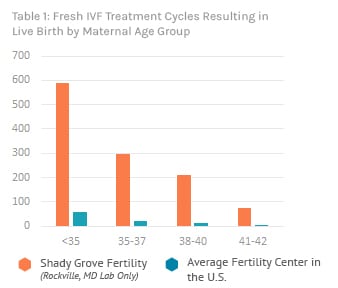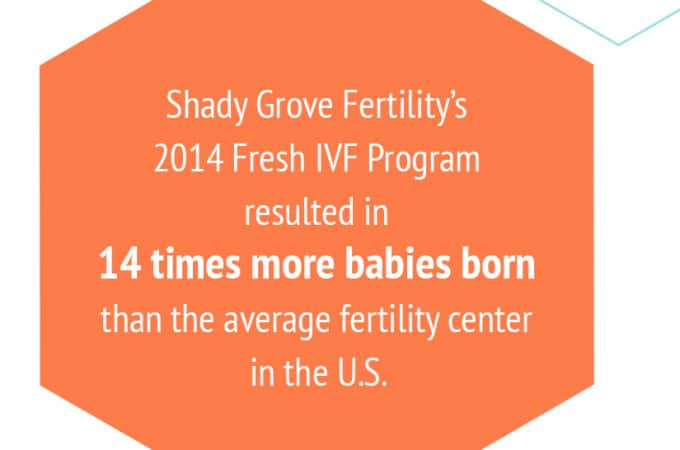How to Understand Infertility Success Rates
Medical Contribution by Eric Levens, M.D. and Stephen Greenhouse, M.D.
This year, the Society for Assisted Reproductive Technology (SART) released its annual infertility success rates report with a few new features to help patients better interpret the data.
As infertility treatment continuously evolves so does the way success rates are communicated. Over the past several years, the frequency of frozen embryo transfers (FET), genetic testing of embryos, and single embryo transfers have each significantly increased and, as a result, outcomes had to be reported if a different manner. These important reporting changes will now allow readers to track outcomes over time for an individual initiated cycle as the data now accounts for both fresh and frozen embryo transfers that result from a single egg retrieval.
The first step to interpret and understand infertility success rates as well as Shady Grove Fertility’s 2014 SART infertility success rates is to understand the new changes and the language used throughout SART reports. This article will be helpful to better understand infertility success rates along with the changes in reporting and what that means to couples considering fertility treatment.
Change #1: Cumulative Live Birth Outcomes
A high number of in vitro fertilization (IVF) and donor egg cycles will result in excess embryos being frozen and then used in a subsequent FET cycle. To better represent this change in treatment, SART changed the focus to reflect cumulative pregnancies from a single stimulation cycle, which is a better indicator of reproductive efficiency.
According to SART.org, a cumulative live birth outcome “reflects the chance of achieving a live birth after a fresh or frozen embryo transfer within a year of a cycle initiated for egg retrieval. The live birth may have been the primary outcome (from the first fresh or frozen embryo transfer) or a subsequent outcome (frozen embryo transfers).”
Change #2: Delivery Timing: Term, Pre-Term, and Very Pre-Term
Another significant addition made by SART is new reporting on the rate of term, pre-term, and very pre-term deliveries. There are many factors that can impact the timing of delivery, one of the most common being the occurrence of multiples. When undergoing IVF treatment, twins and triplets are generally due to transferring multiple embryos.
It is well known that multiples can increase the risks associated with pregnancy to both the mother and babies. For this reason, the physicians at SGF suggest transferring a single embryo in good prognosis patients. Retrospective data has shown that transferring a single embryo does not significantly impact the pregnancy rate but does drastically reduce the rate of multiples.
With the addition of this information readers can now see, by patient age, the rate of term, pre-term, and very pre-term babies. This information, which can correlate to the health of the baby(ies), can help the reader gauge their chances of a high-risk pregnancy.
Change #3: Preliminary Clinic Summary Report (CSR) vs. Final Clinic Summary Report
Many patients may initiate a treatment cycle, undergo the ovarian stimulation and the egg retrieval, but delay the transfer of any resulting embryos to potentially a different calendar year. This commonly happens when the couple chooses to have their embryos genetically tested or if they are banking their embryos for future use.
Now when the CSR is released, it will be labeled as “preliminary.” In the year following, the data will be updated with any transfers occurring and labeled as “final.” This important new step will give readers a more accurate look at their chances of success.
Important Terminology to Understand Infertility Success Rates
While SART has made some significant changes this year in the way they present the data, the terminology used for infertility success rates has not changed. Before viewing infertility success rate data, it’s helpful to learn the terminology associated with reporting assisted reproductive technology.
- Cancellation: Unfortunately, some cycles will have to be cancelled before an egg retrieval can occur. This is usually due to a poor response to medication. It’s in the best interest of the patient to cancel the cycle rather than continue to egg retrieval if a positive outcome is very unlikely. Age is just one example of a factor that affect how well a woman’s body responds to the ovarian stimulation.
- Clinical pregnancy: A clinical pregnancy refers to the identification of a pregnancy sac in the uterus—not just a positive pregnancy test. When reviewing any fertility center’s infertility success rates, it may seem that the clinical pregnancy rates seem low; however, it is important to remember, that not every egg will result in a pregnancy. While the physicians and embryologists do everything in their power to help patients build their families, there is an element of ‘nature’ at play, not just science. For a fertile couple, with the female partner under 35, their chance of pregnancy on any given month is just 15 to 20 percent.
- Cycle starts: A cycle start refers to the start of medications with the intent to proceed with in vitro fertilization (IVF) treatment, whether or not the individual patient was able to continue with treatment.
- Live birth rate: The live birth rate represents the number of patients who have delivered a baby. This number will always be lower than the clinical pregnancy rate due to the possibility of miscarriage. The live birth delivery rate is the most important number to Shady Grove Fertility, as we define success in the same way you do—taking home a baby.
- Miscarriage: Unfortunately, miscarriage—or spontaneous pregnancy loss—is common for all women, regardless of whether they are using infertility treatment to conceive. In fact, it is estimated that one in four pregnancies result in a miscarriage, oftentimes before the woman realizes she is pregnant.
- Retrieval: An egg retrieval is the actual attempt to obtain eggs from the ovarian follicles. In order to get to the stage of embryo transfer (in which a physician places a fertilized embryo into the woman’s uterus), a successful retrieval must occur. The difference in number of egg retrievals to initiated cycles is the cancellation rate.
- Transfer: An embryo transfer is the placement of one or more embryos back into the uterus. A transfer can only occur after fertilization of the retrieved eggs and sperm has taken place in the lab and the embryo has been given several days to develop.
It is important to note that not all egg retrievals will result in an embryo transfer. There are times when there are no viable embryos available and other times when genetic testing may be used to detect certain diseases and disorders. Finally, during egg and embryo freezing a transfer would not take place.
Why do success rates vary from center to center?

It’s important to understand that infertility success rates may vary from center to center for many reasons. The most common are patient characteristics, treatment protocols, and laboratory technology. Because of these reasons it is not advised to compare one center to another solely using SART success rates.
When researching a center, it is important to evaluate a combination of outcomes—delivery/live birth rate per initiated cycle, implantation rate, rate of multiples, and the average number of embryos transferred. The time it can take to become pregnant is a major concern for couples who are struggling with infertility. Thus, it’s important to view a center’s ongoing pregnancy/live birth rate in comparison to the initiated cycle rate. If a center has a high ongoing pregnancy/live birth rate, it’s an important indicator of how effectively a center can help you to conceive.
Before deciding on a treatment center, we recommend that you schedule a consult with a physician so that he/she can help you interpret the success rates as they apply to your medical profile and history.
Editor’s Note: This post was originally published in April 2015 and has been updated for accuracy and comprehensiveness as of July 2016.
If you would like to learn more about how to understand infertility success rates or you’re interested in scheduling an appointment with Dr. Greenhouse of the Shady Grove Fertility Fair Oaks, VA office or Dr. Levens of the Shady Grove Fertility Annandale, VA office, or any of our other physicians located throughout MD, VA, PA, or D.C., please speak with one of our new patient liaisons at 877-971-7755.




